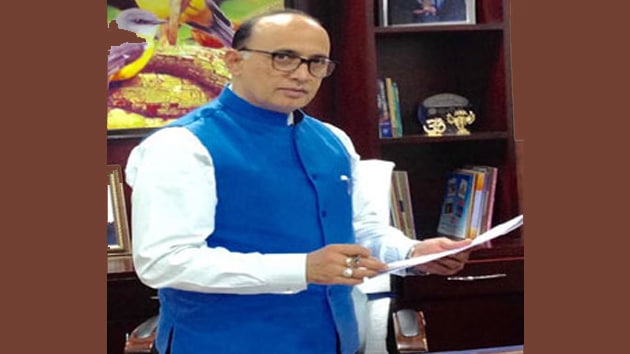
 Jammu and Kashmir National Health Mission (NHM) has been at the forefront of activities directed towards reducing maternal and child mortality. With proper strategy and focussed efforts, the State has witnessed exceptional improvement on this front. Still a lot needs to be done, writes Dr Yashpal Sharma, Mission Director, National Health Mission, Jammu and Kashmir, for Elets News Network (ENN).
Jammu and Kashmir National Health Mission (NHM) has been at the forefront of activities directed towards reducing maternal and child mortality. With proper strategy and focussed efforts, the State has witnessed exceptional improvement on this front. Still a lot needs to be done, writes Dr Yashpal Sharma, Mission Director, National Health Mission, Jammu and Kashmir, for Elets News Network (ENN).
The Government of India recognises child survival and development as essential for overall development of the society. This is reflected in its policies committed to providing adequate services for mothers and children. The same vision is shared by the Government of Jammu and Kashmir which wants to reduce child mortality and morbidity to the lowest achievable levels. J&K National Health Mission (NHM) has been at the forefront of activities directed towards reducing maternal and child mortality. The additional support provided to the existing health systems after launch of NHM has been instrumental in decreasing child mortality rates. Post 2010 there has been a decrease of around 50 per cent in all child mortality rates. The decrease has been much higher than the decrease at national levels. This has been possible by adopting various strategies under NHM which are directed towards reduction of E-NMR, NMR (Neonatal mortality rate), and IMR (Infant mortality rate) & under five mortality rate in addition to MMR (Maternal mortality rate) & TFR (Total fertility rate).

Trend of reduction in child mortality rates There has been a significant reduction in all child mortality rates in the State from the start of National health mission. Figure 1 is showing the trend of different child mortality rates in the State for the last eight years.



The mortality rates are well below the national average particularly for under five mortality rate (U5MR) which is 26 for State in comparison to national average of 43. Figure 2 is comparing the current status of child mortality indicators at national and State level.

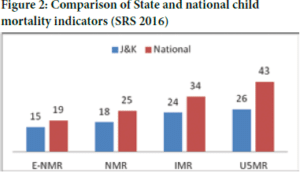
The strategies which were adopted have been discussed below using health system framework. NHM has provided support in all the components of health systems.
Strategies which were adopted Infant mortality rate of a region is determined not only by availability of health services but by interplay of multiple factors which span from education levels of mothers, access to safe drinking water and sanitation and also socio-economic status of overall population. The significant decrease in IMR is attributed to all these factors. National health mission played a significant part in addressing the gaps in health systems ranging from providing leadership to proving support in the form of manpower and capacity building of human resources for health. The strategies which were adopted can be explained by using the health systems framework. These include-
- Leadership and governance: NHM helped in developing program management units at State, divisional and district level which provided the necessary leadership and governance support. These units provided technical support at relevant levels.
- Healthcare financing: Funds for healthcare had always been scarce. India is one of the countries with least public health spending on health in terms of GDP. The public health expenditure in India has remained constant at 1.3% of GDP which is much lower than world average of 6%. The National health policy proposes to increase it to 2.5%. NHM has been able to fill the funding gap to some extent. The State has spent Rs 2,837.5 crore since 2005. These financial resources have been critical in setting up new health infrastructure, upgrading existing infrastructure, provision of human resources for health and providing medical products and consumables. NHM also provided support in upgrading the health infrastructure available in the State. The health facilities were made operational as per population norms.

3.Health workforce: Human resources for health are key components of any health system. The final output of any health system is dependent on available of trained and motivated health workers in requisite number. Providing manpower and then building their capacity has been a core area of intervention on NHM.
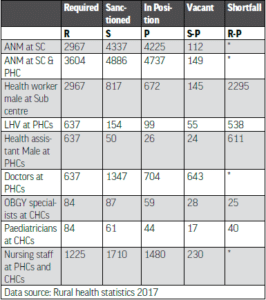
4. Medical products, technologies: Medical products and technologies are an important component for ensuring diagnosis and management of diseases. NHM has provided support in making advanced care available by procurement of these products. It particularly included
- Equipment for SNCU/NBSU and NBCC: Radiant warmers, phototherapy units, oxygen delivery equipment
- Strengthening of ante-natal care diagnostics: ANC Diagnostics by ANM Online, Hb meters, BP Apparatus etc.
- Improving care around birth: Procurement of equipment like delivery sets
5. Information and research: NMH also supported in strengthening the information systems available so that data can be used for action.
6. Service delivery: NHM has been able to improve delivery of key RMNCHA (Reproductive, Maternal, Newborn, Child and Adolescent Health) interventions which impact child mortality. Provision of care across the life cycle has improved due to multiple interventions being implemented by national health mission.
The key intervention under NMH includes:
- Promotion of institutional deliveries through Janani Suraksha Yojana(JSY) and improving access to delivery points by increasing the number of functional delivery points: The period around birth is critical as 46% maternal deaths, over 40% still births and 40% newborn deaths take place around the day of delivery. NHM has been able to increase the number of women having safe delivery to above 80%.
- Improving quality of care provision during ante-natal, intra natal and post natal period: Delivery points were developed and made functional as per population norms. The delivery points were equipped with human resource. Referral network was strengthened. There has been an increase in institutional delivery rate to 85%.
- Facility based newborn care at different levels to reduce child mortality: NHM provided support in strengthening SNCUs (Special newborn care units) in terms of infrastructure, equipment, manpower, drugs and consumables. 24 SNCUs have been established and made functional. Three Neonatal Intensive Care Units (NICUs) at Government Medical Colleges are also being supported under NHM which provide tertiary care management of sick neonates referred from districts. In addition to SNCUs 76 Newborn stabilisation units (NBSUs) and 281 Newborn Care Corners have been established in the State.
- Capacity building of human resources for health: Trained manpower is critical for ensuring quality care. In this regard NHM has conducted/ facilitated multiple training for healthcare workers. The primary training which impact infant mortality include integrated management of neonatal and childhood Illnesses (IMNCI), Navjaat Shishu Suraksha Karyakram (NSSK), Skilled Birth Attendance (SBA), Facility based Newborn care (FBNC), Life Saving Anaesthesia Skills (LSAS), Comprehensive Emergency Obstetric Care (CEmOC), Basic Emergency Obstetric Care (BEmOC). 70 doctors and 88 nurses posted in SNCUs at District Hospitals and NICUs at GMC Jammu / Srinagar have been trained in facility based newborn care training programme. 3369 MOs/ SNs/ANMs have been trained till date under Navjaat Shishu Suraksha Karyakram (NSSK)
- Universal immunisation programme: more children were immunised to ensure protection against vaccine preventable diseases. Proportion children fully immunised had increased to 75%. The State is planning to increase it further to 95%.
- Infant and young child feeding: the breast feeding rates and malnutrition rates in children have decreased in last decade. The State will be rolling out newer interventions like home based care of young child (HBYC) to improve child feeding practices further.
- Reducing out of pocket expenditure by Janani“ Shishu Suraksha Karyakram (JSSK): State has been able to provide free care to all pregnant women and neonates under JSSK.
- Other national health programmes: NHM has also rolled out all national health programmes with good coverage which include intensified diarrhoea control fortnight (IDCF), Mothers absolute affection (MAA).
Changes in key coverage indicators in NFHS 4 compared to NFHS 3
Way forward
The State envisions a health system that eliminates preventable deaths of children and still births, where mothers and children survive, thrive and reach full

potential.The specific goal is to achieve single digit IMR by year 2022. To achieve single digit IMR by year 2022 the State needs to accelerate the rate of decline in IMR
Figure 3: Acceleration in rate of decline required to achieve single digit IMR
Accelerated efforts will be required to improve care provided to prospective mothers. It would be needed right before conception till and after delivery. In addition to
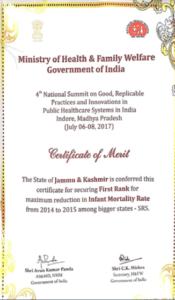
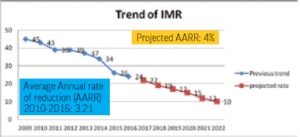
strengthening existing activities, new strategies will need to be put in place for accelerating the growth.
Key interventions to be started/ strengthened for achieving this target
- Pradhan Mantri surakshit Matritva Abhiyaan (PMSMA)
- Dakshata for improving care around birth
- Home based care of young child (HBYC)
- Family centred care and KMC
- Integrated management of diarrhoea and pneumonia in children.
Be a part of Elets Collaborative Initiatives. Join Us for Upcoming Events and explore business opportunities. Like us on Facebook , connect with us on LinkedIn and follow us on Twitter , Instagram.
"Exciting news! Elets technomedia is now on WhatsApp Channels Subscribe today by clicking the link and stay updated with the latest insights!" Click here!
















